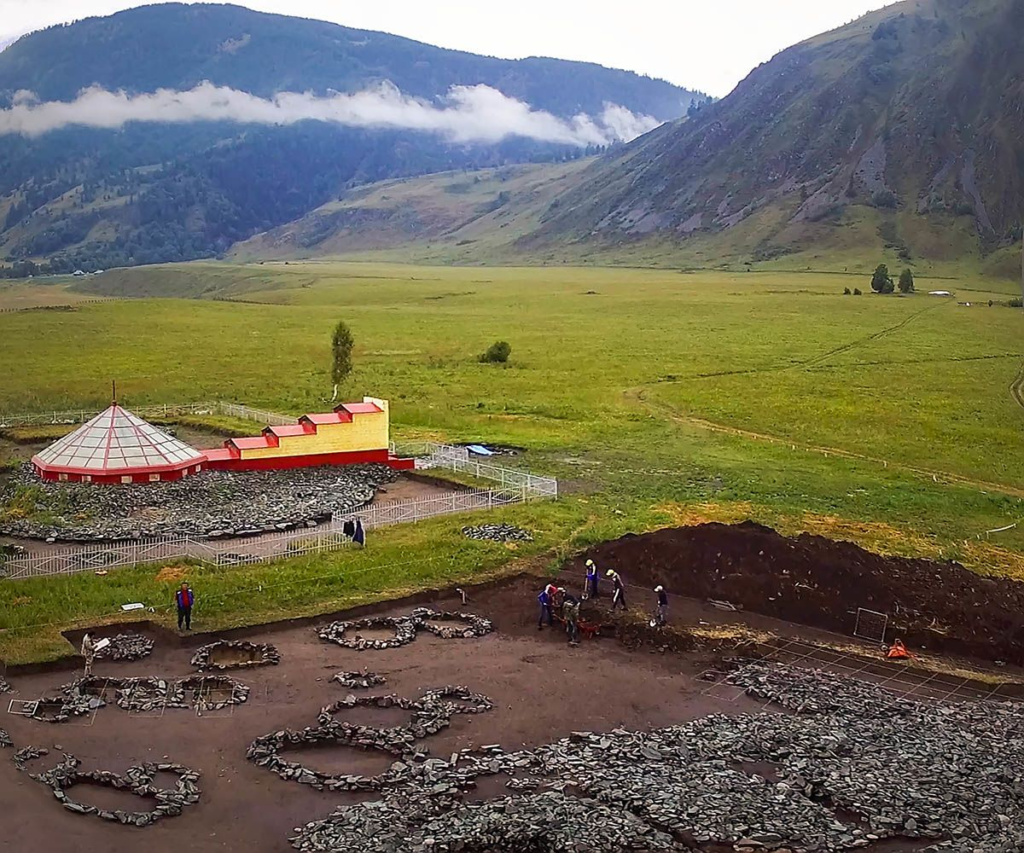© 2026. anyz.pushkinlibrary.kz All rights reserved.
Screen reader

(Source: Shygys Kazakhstan Anızdary, Ertegileri= Legends, legends of East Kazakhstan. – Semey: Artex, 2018. – 122 p.)
Long ago, in the high valley of Berel lived a free-standing tribe of vultures. They owned gold mines and mines, so they were called «vultures, guarding gold». From the gold of Berel, like the sun, skilled craftsmen made graceful things from which it was difficult to look away. Vultures liked to depict fantastic animals and monstrous half-birds on all their products and monstrous half-birds – half-beasts – griffins, which were called «dogs of Zeus». But the military craft was considered the main in those lands. People of the tribe were excellent riders. Like arrows fired, they flew on their horses on the steppe. Even pursued by the enemies, they shot them with arrows without a hitch, half turning in their saddles. The ruler of the vultures was a brave and strong-willed man named Alpan (translated from Turkic means «brave»). On his neck he wore massive pendants depicting a three-dimensional elk head in the beak of an eagle griffin.
The fairy riches of the vultures did not give rest to the surrounding tribes, who tormented envy day and night, because the gold of Berel blinded the eyes of people like the sun. In the vicinity of the vultures lived tattooed arimasps (translated from Greek – «one-eyed people»). Drawing a huge eye on their forehead, they thought they were careful and attentive. Historian Herodotus mentioned the arimasps. And Aeschylus wrote: «Be afraid of the hornbill vultures, the one-eyed Rati arimasp. Do not approach them!» During the raids, the Arimaspas burned settlements of vultures and took the gold they had mined.
Skinhead argyppaeans, Issedons and other neighbouring tribes also occasionally attacked vultures. But the ruler of the vultures was a wise commander who showed his warriors a shining example of fearlessness. He suffered several fractures to his ribs and cervical vertebrae during armed encounters with the enemy, but was in excellent health, recovering quickly from his injuries, and as soon as the fractures healed, he personally participated in the battles. Once a fortune-teller predicted the superstitious head of the Arimasp tribe Bahir (translated from Turkic «blinding») that the leader of the vultures would soon have a boy with more gold than all the other chiefs put together. Bahir believed the prophecy and was afraid. He wanted to destroy Alpan at all costs.
One day, during a lull in civil strife, Alpan decided to relax and went hunting. Many loyal vultures went with him. They managed to lasso the fox, the hare, and two saiga. Proud and happy, the riders returned home through the flowering field. Everyone was looking forward to the joy of meeting their mothers, wives and children, and their excited voices carried far along the steppe. There was only one chief who was thoughtful, and he had some doubts. As he approached the village, he suddenly wished to be alone: he sent the weary warriors forward with his prey, and he himself let the horse into the stream. The alpan dismounted and sat down on the stone by the water. The foliage scrambled quietly, the water murmured slowly, calming the pounding heart. Suddenly the silence broke some rustle, and before him appeared his old foe – Bahir. The cunning Arimasp tracked down and ambushed a sworn enemy by tying up his horse nearby. Alpan did not expect to be dared to attack near the house. The surprise of the attack gave the enemy an advantage, and yet Bahir met a furious.
On the final journey, the chief was taken by chariot. The grieving mother wanted to bury her son with all manner of honors, as a gentleman of his rank was supposed to. His soldiers dug a huge hole and built for him a grand tomb of stones and cut down trunks of centuries-old larch trees. Alpan was buried in luxurious clothes embroidered with beads and decorated with thousands of plates in the form of small figurines of animals of pure gold Berel, similar to the sun. In the kurgan together with the Supreme Leader buried 13 stallions «golden» suit (fire-red), which were to accompany him to another world.
The mother of Alpan supervised the organization of the passage of the son to another life. But when all the necessary procedures were over, and a large mound, called the people «golden», it was possible to fall asleep, she considered her maternal debt fulfilled and died of grief and longing. Just a few months after her son’s death, she was buried next to him in clothes richly embroidered with jewels and Berel gold similar to the sun.
Later, due to the terrible drought, the legendary griffins, arimaspas, argyppaeans, and issedons settled in the world. Historians consider these places to be the homeland of the Kipchaks, a Turkic-speaking people engaged in nomadic herding and crafts. Almost the entire territory of modern Kazakhstan was the domain of the Kipchak and was named Kipchak Steppe. According to one version of scientists Kipchaks, whose descendants became Kazakhs, descended from Sary-Kipchak («sary» translated from Ancient Turkic as «yellow») – they could be called so because of blond hair or the popular fire-red horse suit or the gold they had like the sun. Hence, from Kazakh soil, the Kipchak culture spread throughout the world, along ethnic groups, languages and religions. About military valor of Kypchakov the Kazakh people has put proverbs: «Where courage, there is victory», «Happiness is always on the side of the courageous», «The enemies of clouds are not feared if the warriors are mighty», «On their land they did not go in bondage».
© 2026. anyz.pushkinlibrary.kz All rights reserved.
Screen reader
Write to us, we will contact you as soon as possible